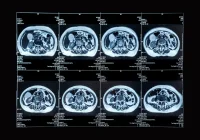Interval cancers—those diagnosed within a year following a negative mammogram—pose a significant clinical concern due to their typically aggressive nature and poorer outcomes. Despite the adoption of digital breast tomosynthesis (DBT), which has enhanced several screening performance metrics, its introduction has not led to a statistically significant reduction in false-negative rates when compared to digital mammography alone. While previous studies have assessed AI's ability to identify missed cancers in digital mammography, little has been done to explore its role in screening DBT. The application of AI in this context aims to reduce the interval cancer rate and, by extension, improve patient outcomes.
Performance of AI in Detecting Interval Cancers
A retrospective analysis was conducted on 224 interval cancer cases using a U.S. Food and Drug Administration–cleared AI algorithm. Each DBT examination was assigned a score based on the most suspicious lesion, with a threshold of 10 or higher indicating a positive result. The algorithm correctly identified and localised 32.6% of interval cancers. Notably, cancers with scores above 50 were correctly marked in 87% of cases. These findings demonstrate that AI has the capability to identify a substantial proportion of cancers that had initially been missed during routine screening.
Must Read: Transforming Breast Cancer Diagnostics with Generative AI
Further insights emerged from the comparison of features between interval cancers detected and not detected by the AI algorithm. Tumours detected by AI were significantly larger and more likely to have lymph node involvement. No significant differences were noted in age, race or breast density. Architectural distortion on mammography was more commonly associated with AI-detected interval cancers. These results suggest that AI is more likely to identify biologically aggressive and more clinically evident cancers.
Comparison with Asymptomatic and Screening-Detected Cases
In addition to interval cancers, the AI algorithm was tested on asymptomatic false-negative cancers and screening-detected true-positive cases. Among the 152 asymptomatic false-negative cancers, AI correctly identified only 17.8%, significantly lower than the detection rate for interval cancers. Patients with asymptomatic cancers detected by AI were younger, and calcifications were a more common feature in these cases. This suggests that AI may be less sensitive to cancers that are typically smaller or detected through supplemental imaging rather than presenting symptoms.
The AI algorithm also analysed 1000 DBT examinations categorised as true-positive, true-negative and false-positive. The algorithm correctly localised 84.4% of true-positive cancers and accurately categorised 85.9% of true-negative and 73.3% of false-positive cases as negative. Among true-positive cases, those detected by AI were more likely to involve invasive ductal carcinoma and less likely to be ductal carcinoma in situ. The masses identified tended to have distinct mammographic features, such as architectural distortion and asymmetry, while calcifications were less commonly detected by AI. These findings indicate that AI is especially effective at identifying more advanced or aggressive malignancies that may be missed during routine interpretation.
Implications for Screening and Clinical Practice
The use of AI in DBT screening shows promise in reducing the interval cancer rate, potentially by nearly one-third. By identifying larger and more aggressive tumours that might otherwise go unnoticed, AI contributes to earlier intervention and improved prognoses. Importantly, the algorithm achieved this level of performance without a significant increase in false-positive rates, supporting its clinical utility in a real-world screening environment.
Dense breast tissue, which was present in two-thirds of the analysed cases, remains a known challenge for radiologists. AI's ability to detect cancers in dense tissue environments further highlights its value in addressing limitations associated with traditional screening. However, successful integration of AI tools into clinical workflows requires radiologists to interpret and act upon the AI findings, as these tools serve to support, not replace, human decision-making.
The study is not without limitations. The generalisability of the results may be constrained by practice-specific factors such as radiologist expertise, use of supplemental screening and differences in screening intervals. Additionally, while the dataset is among the largest single-institution cohorts of DBT-detected interval cancers, the absolute number of cases remains modest. Some potential misclassifications could also arise due to patients receiving follow-up care at different institutions.
AI integration into DBT screening has demonstrated its potential to reduce the interval cancer rate and support earlier detection of aggressive breast cancers. By accurately identifying nearly one-third of interval cancers and maintaining high performance across various screening categories, AI represents a significant advancement in breast cancer screening. Ongoing research and broader validation across multiple institutions will be essential to fully realise the benefits of AI in routine clinical practice.
Source: Radiology
Image Credit: iStock










